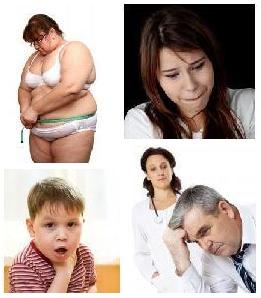- Updated on November 1, 2020
![]() By Dr. Artour Rakhimov, Alternative Health Educator and Author
By Dr. Artour Rakhimov, Alternative Health Educator and Author
- Medically Reviewed by Naziliya Rakhimova, MD
Causes of hyperventilation are seriously misunderstood by mainstream medicine. Internet (Wikipedia, etc.) and professional medical sources grossly misrepresent the prevalence of hyperventilation primarily limiting it to such cases as lung injuries, extreme stress, diabetic ketoacidosis, head injuries, and stroke. In reality, research provides a different view on the presence and prevalence of hyperventilation (breathing more air than the medical norm).
Minute ventilation rates (chronic diseases)
| Condition | Minute ventilation |
Number of people |
All references or click below for abstracts |
| Normal breathing | 6 l/min | – | Medical textbooks |
| Healthy Subjects | 6-7 l/min | >400 | Results of 14 studies |
| COPD | 14 (+-2) l/min | 12 | Palange et al, 2001 |
| COPD | 12 (+-2) l/min | 10 | Sinderby et al, 2001 |
| COPD | 14 l/min | 3 | Stulbarg et al, 2001 |
| Cancer | 12 (+-2) l/min | 40 | Travers et al, 2008 |
| Heart disease | 15 (+-4) l/min | 22 | Dimopoulou et al, 2001 |
| Heart disease | 16 (+-2) l/min | 11 | Johnson et al, 2000 |
| Heart disease | 12 (+-3) l/min | 132 | Fanfulla et al, 1998 |
| Heart disease | 15 (+-4) l/min | 55 | Clark et al, 1997 |
| Heart disease | 13 (+-4) l/min | 15 | Banning et al, 1995 |
| Heart disease | 15 (+-4) l/min | 88 | Clark et al, 1995 |
| Heart disease | 14 (+-2) l/min | 30 | Buller et al, 1990 |
| Heart disease | 16 (+-6) l/min | 20 | Elborn et al, 1990 |
| Pulm hypertension | 12 (+-2) l/min | 11 | D’Alonzo et al, 1987 |
| Asthma | 13 (+-2) l/min | 16 | Chalupa et al, 2004 |
| Asthma | 15 l/min | 8 | Johnson et al, 1995 |
| Asthma | 14 (+-6) l/min | 39 | Bowler et al, 1998 |
| Asthma | 13 (+-4) l/min | 17 | Kassabian et al, 1982 |
| Asthma | 12 l/min | 101 | McFadden, Lyons, 1968 |
| Cystic fibrosis | 15 L/min | 15 | Fauroux et al, 2006 |
| Cystic fibrosis | 10 L/min | 11 | Browning et al, 1990 |
| Cystic fibrosis* | 10 L/min | 10 | Ward et al, 1999 |
| CF and diabetes* | 10 L/min | 7 | Ward et al, 1999 |
| Cystic fibrosis | 16 L/min | 7 | Dodd et al, 2006 |
| Cystic fibrosis | 18 L/min | 9 | McKone et al, 2005 |
| Cystic fibrosis* | 13 (+-2) l/min | 10 | Bell et al, 1996 |
| Cystic fibrosis | 11-14 l/min | 6 | Tepper et al, 1983 |
| Diabetes | 12-17 l/min | 26 | Bottini et al, 2003 |
| Diabetes | 15 (+-2) l/min | 45 | Tantucci et al, 2001 |
| Diabetes | 12 (+-2) l/min | 8 | Mancini et al, 1999 |
| Diabetes | 10-20 l/min | 28 | Tantucci et al, 1997 |
| Diabetes | 13 (+-2) l/min | 20 | Tantucci et al, 1996 |
| Sleep apnea | 15 (+-3) l/min | 20 | Radwan et al, 2001 |
| Liver cirrhosis | 11-18 l/min | 24 | Epstein et al, 1998 |
| Hyperthyroidism | 15 (+-1) l/min | 42 | Kahaly, 1998 |
Dozens more medical studies prove the same fact: not only people with chronic disease but nearly all so-called “normal subjects” breathe about 12 L/min (double the medical norm) – see the graph with historical changes in breathing below.
 Since over 90% of the modern population has chronic hyperventilation hidden in the modern lifestyle. The aspects of the modern lifestyle that represent causes of hyperventilation are supine sleep, mouth breathing, exercise with mouth respiration, laziness, overeating, oversleeping, overheating, slouching, addictions, and many other “innovations” that intensify basal breathing (or breathing at rest) and decrease body-oxygen content.
Since over 90% of the modern population has chronic hyperventilation hidden in the modern lifestyle. The aspects of the modern lifestyle that represent causes of hyperventilation are supine sleep, mouth breathing, exercise with mouth respiration, laziness, overeating, oversleeping, overheating, slouching, addictions, and many other “innovations” that intensify basal breathing (or breathing at rest) and decrease body-oxygen content.
Russian medical doctors practicing the Buteyko breathing technique have investigated the causes of hyperventilation for more than 4 decades. They suggested that the main cause of hyperventilation is lack of physical exercise with nose breathing. (Note that nasal breathing during physical activity was very common some 80-100 years ago and before that even among competing athletes.)
 The search for hyperventilation causes is easy if we consider medical studies related to historical changes in breathing rates (minute ventilation) in normal subjects during the last 80 years.
The search for hyperventilation causes is easy if we consider medical studies related to historical changes in breathing rates (minute ventilation) in normal subjects during the last 80 years.
Only 70-80 years ago, as this graph (based on 24 medical studies) testifies, breathing of ordinary people (so-called “normal subjects”) was very different from the breathing of modern people. Modern people breathe about 2-3 times more air. Modern people also breathe about twice more than the medical norm for breathing. (Click on the graph to see and read all 24 references.)
Main hyperventilation causes
Modern civilization has brought about some negative changes affecting our breathing and health, which cause hyperventilation in modern populations. Among the main causes of hyperventilation are abnormal changes in our lifestyle in the areas of physical exercise, diet, sleep, rest and relaxation, thermoregulation, talking, and many others. These causes of hyperventilation are considered on separate pages:
 * Lack of Earthing or electrical connection with Earth that causes a shortage of electrons leading to abnormal inflammatory response, ineffective nerve and muscle function and hyperventilation
* Lack of Earthing or electrical connection with Earth that causes a shortage of electrons leading to abnormal inflammatory response, ineffective nerve and muscle function and hyperventilation
* Sedentary lifestyle – Sedentary lifestyle causes reduced brain and body oxygen levels. This leads to poor physical fitness and reduced desire to exercise or even move around
* Mouth breathing – Mouth breathing was a socially unacceptable habit and its CO2- and nitric oxide-related effects affect all cells and organs of the human body
* Sleep factors – Our sleep conditions drastically deteriorated due to worsened air quality, the introduction of soft beds, warm blankets, sleeping on one’s back and mouth breathing during sleep
* Psychological stress – While people in the past had the same magnitude and amount of stress, modern people, due to chronic hyperventilation, have reduced abilities to face their life challenges
* Overeating – While the food was scarce in the past, the current abundance of junk food, modern advertisement techniques, and social overeating cause devastating effects on breathing causing chronic hyperventilation
* Overheating – High temperatures indoors, excessive clothing, wearing warm clothes indoors, overheating of children are among the causes of hyperventilation
* Lack of nutrients – Food and meals were simpler and more natural before the advance of modern agricultural (-cultural?) methods, while junk food is one of the causes of hyperventilation
* Toxins and pollution – These days they can come from air, food, and water
* Stop slouching – Old movies and photos show that straight spine (for diaphragmatic breathing and normal blood oxygenation – 98%) was the norm 1-2 centuries ago. The appearance of sofas, couches, armchairs, and modern chairs with negative incline (knees are higher than buttocks) causes slouching and leads to chest breathing promoting hyperventilation
* Talkativeness – People used to be less talkative some decades ago, while modern people are very eager to “express” themselves
* Singing – Why do singers die early? – Overbreathing reduces its body O2 and leads to possible addictions, health problems.
* Swaddling babies: when and why – Swaddling was one of the ancient wise traditions that has been lost for decades, but, thanks for recent medical research and trials, it is again encouraged by official mainstream medicine
* Other factors.
All these factors leading to hyperventilation are discussed in more detail on the web pages of this Section. Note that these are the most common causes of abnormal breathing. In addition, people often have many other, more personal factors that can intensify their breathing. They are considered in the Learning Section of this website, where one can find out more complete practical instructions related to health and risk lifestyle factors and related topics.
This YouTube video (there are several others) considers some causes of hyperventilation.
Prevalence, symptoms and, treatment of hyperventilation
|
Hyperventilation causes are individual and can vary over time for the same person. For example, a healthy athletic young man, after graduation, may become less active physically. His breathing gets heavier and the morning CP drops to about 20 s. After some years he starts to sleep on his back. … Read more …. |
People in the past. Do old movies and films show that people’s breathing pattern in the past was different? 1. People kept their mouths shut. 2. People spent hours while reading, speaking, and working in the correct posture… Read more … |
|
How is it possible that a human being, one of the smartest species on Earth, can kill himself, and over 90% of people die this way, by overbreathing? Is nature so silly to create us this way? In order to answer these questions, we need to consider changes in air composition on Earth … |
Since primitive air had very little O2, our evolutionary predecessors could get more oxygen in tissues only by breathing more. Could it be so that this was the reason why hyperventilation became the main reflex or drive of the human organism? … |
| The prevalence of hyperventilation is very high. More than 90% of the sick and normal subjects breathe over 10 L/min, while the medical norm is only 6 L/min. Healthy people, however, have only about 6-7 L/min … Read more: | Common symptoms of hyperventilation are anxiety, bronchospasm, constipation, coughing, muscle cramps, nasal congestion, sighing, shortness of breath, angina pain, … Read more: | Successful treatment of hyperventilation is based on those breathing exercises that reduce minute ventilation at rest and increase alveolar CO2 levels. Correction of lifestyle risk factors is necessary too. More info: |
Based on my work with hundreds of breathing students, I discovered the combined method that allows us to address the main causes of hyperventilation and restore normal breathing with the least amount of effort. The general idea of this approach is provided below as your bonus content.
You need to apply the lifestyle of the Buteyko breathing method, but apply breathing exercises with the DIY or Frolov breathing device. Buteyko exercises are better and easier to learn later when you have up to 25 s for the Buteyko CP test.
[/sociallocker]


